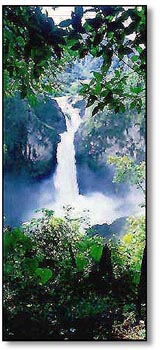Geographically, Ecuador can be divided into three primary regions: the Coastal Lowlands, the Central Highlands, and the Eastern Rainforest Basin.
The inhabitants of the coastal lowlands, especially those of Guayaquil, have long considered themselves a breed apart. Though travelers are greeted warmly, the coastal regions were so resistant to the Spanish that African slaves had to be brought in to provide a labor base to work the rich farmland. Tied to this independent sentiment is a land of roaming beaches, luxuriant plains, and dense mangrove forests. Some of the world's best preserved mangrove forests can be found along the northern coast. A ride on a pongu boat through the dark, hidden world of the mangrove tree enlightens the visitor to one of the most ecologically important environments in Ecuador. More than beautifully intricate, the meshy roots of the mangrove offer protection to the spawn of oceanic fish, which come to the forests to breed. In the branches above, colorful toucans and a host of other birds provide dizzying acoustics.
Guayaquil
Located at the mouth of the Guayas River, this coastal city has always been the largest and most liberal-minded in Ecuador. Its fiercely independent and progressive populace has at times rebelled against the government in Quito. Today, it is a city of 2 million, and some historians explain that the reason Guayaquil is not the nation's capital is because the Spanish found Quito easier to control. Guayaquil's history of trading dates back thousands of years, and its markets are still a big attraction. People come from all over Ecuador to hawk their goods here, and bargains abound.
The most dramatic geographical feature of Ecuador is its central highlands. Here, a soaring stretch of the Andes splits into two local ranges, demarcating a magnificent central valley. The German explorer Humbolt aptly dubbed this valley the Avenue of the Volcanoes, for along it range most of Ecuador's 51 volcanic peaks, 21 of which are presently active. Many wear snowy crowns all year round. The highest peak is Chimborazo, rising 6,310 meters. At the northern end of the valley is Ecuador's capital city, Quito.
At 2,850 meters (9,360 ft), Quito is the second highest capital in the world. It is also one of South America's most entrancing cities, possessing a balmy climate, a wealth of fine Spanish colonial architecture, and a magnificent setting at the base of Pichincha volcano. Quito was a major stronghold of the Inca, defended by the general Ruminahui for two years after the Spanish arrived. Realizing that the Spanish would eventually take the city, Ruminahui destroyed it himself and fled. The chagrined Spanish quickly rebuilt upon the site, and today it has a population of just over a million.
Quito has been the seat of Ecuadorian government since 1830 and a bastion of conservatism throughout Ecuador's modern history. The old city center harbors many of the country's museums as well as markets and plenty of colonial churches and plazas. An infamous and periodically violent rivalry exists between Quito and the coastal city of Guayaquil.
Cotopaxi National Park
It is hard to miss this park's main attraction, even from twenty miles away. At 19,460 feet (5897 meters), Mount Cotopaxi is the world's second highest active volcano. Worshipped by locals for its remarkable symmetry, the mountain has been known to reward adoration with destruction. Since 1534, when the invading Spanish were dumbstruck by an eruption, the Cotopaxi has erupted nine times, most recently in 1942. In 1887, mud slides blasted down its slopes after an eruption sparked glacial melting, annihilating several nearby cities. For climbers, as for local residents, the mountain is a pilgrim's destination. It was first scaled in 1872 by Wilhelm Ross, a German, and Colombian Angel Escobar. A later ascent from the North by the British Edward Whymper established the most popular route to the crater. Cotopaxi lies about 40 miles south of Quito.
Chimborazo National Park
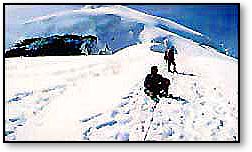 Located about 100 miles south of Quito, this park is the site
of a uniquely insensible geographical marvel--the misty peak of Mount
Chimborazo, which marks the farthest point from the center of the Earth.
The distinction is caused by planetary bulging at the equator. The peak
of this monstrous volcano is Ecuador's highest point at 20,823 feet.
Located about 100 miles south of Quito, this park is the site
of a uniquely insensible geographical marvel--the misty peak of Mount
Chimborazo, which marks the farthest point from the center of the Earth.
The distinction is caused by planetary bulging at the equator. The peak
of this monstrous volcano is Ecuador's highest point at 20,823 feet.
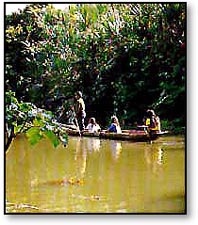 Along the
eastern slope of the Andes is found one of the world's richest and most
accessible rainforest regions, an area that vibrates with life. An astounding
one-third of all the Amazon's bird species can be found here, as well
as 10 percent of the world's tree species. Massive flows of water from
the Andes collect in the Napo and Aguarico river basins, creating the
foundation for the Oriente's teeming biodiversity. It typically rains
at least once a day, and rubber boots are highly recommendable. The Napo
is one of the Amazon River's principal tributaries, and included in its
fauna are sloths, caymans, jaguars, monkeys, tapirs, pink dolphins, and
over 1,000 species of birds.
Along the
eastern slope of the Andes is found one of the world's richest and most
accessible rainforest regions, an area that vibrates with life. An astounding
one-third of all the Amazon's bird species can be found here, as well
as 10 percent of the world's tree species. Massive flows of water from
the Andes collect in the Napo and Aguarico river basins, creating the
foundation for the Oriente's teeming biodiversity. It typically rains
at least once a day, and rubber boots are highly recommendable. The Napo
is one of the Amazon River's principal tributaries, and included in its
fauna are sloths, caymans, jaguars, monkeys, tapirs, pink dolphins, and
over 1,000 species of birds.
Cayamba-Coco Ecological Reserve
Located in the Oriente, Cayamba-Coco is Ecuador's largest national park. It is, quite simply, a gigantic swath of life bursting off the face of the Earth. Ten million acres of rainforest and cloud forest rest here in the shadows of the Andes. Daunted by the task of developing the huge reserve for tourism, the government has done very little with Cayamba-Coco. Tourists tend to stick to the beaten path and the amenities it offers, making this park a truly wild experience. In addition to the countless bird, mammal, and tree species found everywhere in the Oriente, Cayamba-Coco also provides a good place to spot the rare Andean Vulture.
Cuyabeno Wildlife Reserve
There are more species of birds in the Amazon than anywhere else on the planet. One-third of those species roost here, making Cuyabeno's 85,000 acres the most diverse avian sanctuary on the planet. A roam along the well-developed trails blesses hikers in this park with an unforgettable experience. In the trees above, macaws, toucans and endless breeds of other birds flash staggering colors while the air pulsates with their songs and calls. Bring binoculars, as well as a flashlight to view the nocturnal species.
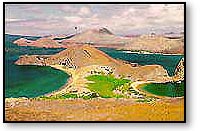 The archipelago is a little world within itself, or rather
a satellite attached to America, whence it has derived a few stray
colonists, and has received the general character of its indigenous
productions. Considering the small size of these islands, we feel the
more astonished at the number of their aboriginal beings, and at their
confined range. Seeing every height crowned with its crater, and the
boundaries of most of the lava-streams still distinct, we are led to
believe that within a period, geologically recent, the unbroken ocean
was here spread out. Hence, in both space and time, we seem to be brought
somewhat nearer to that great fact--that mystery of mysteries--the
first appearance of new beings on this earth.
The archipelago is a little world within itself, or rather
a satellite attached to America, whence it has derived a few stray
colonists, and has received the general character of its indigenous
productions. Considering the small size of these islands, we feel the
more astonished at the number of their aboriginal beings, and at their
confined range. Seeing every height crowned with its crater, and the
boundaries of most of the lava-streams still distinct, we are led to
believe that within a period, geologically recent, the unbroken ocean
was here spread out. Hence, in both space and time, we seem to be brought
somewhat nearer to that great fact--that mystery of mysteries--the
first appearance of new beings on this earth.
Charles Darwin, Voyage of the Beagle
Location, Geography , Climate
Ecuador's most beloved and popular national park lies in splendid isolation about 960 kilometers off the mainland. Made famous by Charles Darwin, the Galapagos Islands are no less enthralling now than they were a hundred years ago. Every year, thousands of curious visitors journey to the remote islands to behold the wondrously variegated wildlife that inspired The Origin of Species.
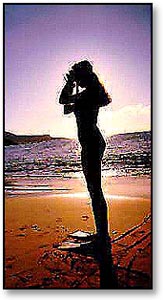
The climate in the islands is generally mild and comfortable. From June to December, the Humbolt current rises up from Antarctica, its cooler air bringing in the rainy season. In January, the Humbolt's withdrawal allows the warmer equatorial current to move in, bringing with it a dry season that endures through May.
History
In the fall of 1885, the Galapagos Islands' most famous visitor, Charles Darwin, arrived on the H.M.S. Beagle and began collecting and observing the archipelago's unique animal and plant life. At the time, Darwin did not fully appreciate what he was seeing. Only after he returned home to England did the scientist begin to formulate his theory of evolution. Though the name Darwin is inseparable from the islands' history, they were actually discovered in 1535 by a Spanish bishop named Fray Tomas de Berlanga, who named the island Galapagos after the impressive giant tortoises.
Much of the same flora and fauna that inspired Darwin's The Origin of Species still thrives on the Galapagos today. Appropriately, ninety-seven percent of the island is national park. The legendary marine and land iguanas, the giant tortoises, and seal colonies of the Galapagos are among nature's most fantastic beings. Visitors will gasp at these stunning animals, all of which are highly approachable as their isolated evolution has not conditioned them to fear humans. Iguanas and tortoises bask in the sun like bored movie stars, feet away from the photo-snapping Homo Sapiens. Though their indifference may make the animals seem humorously aloof, their very ignorance makes them vulnerable. A few bad experiences with humans can alter their behavior irrevocably and turn them reclusive. Respect their natural hospitality and keep your hands to yourself.
The Galapagos also offer some of the world's best scuba diving. Dive boats that tour the islands can be reserved on the mainland. Devil's Crown, an atoll near Floreana Island, is a submarine wonderland that shouldn't be missed. The shallows of this sunken volcano are burgeoning with an incredible myriad of corals and fish. Giant tortoises hover over the reef like living balloons, and sharks can sometimes be found, harmless and asleep on the sandy bottom.
The flight from Guayaquil takes about an hour and a half, and visitors can land on either Baltra or San Cristobal. Upon reaching the Galapagos, the only way to tour the islands is to do it the way Darwin did, by boat. Due to the biologically sensitive nature of the islands, trips ashore must be taken in the presence of a licensed guide. They come with the boat.
